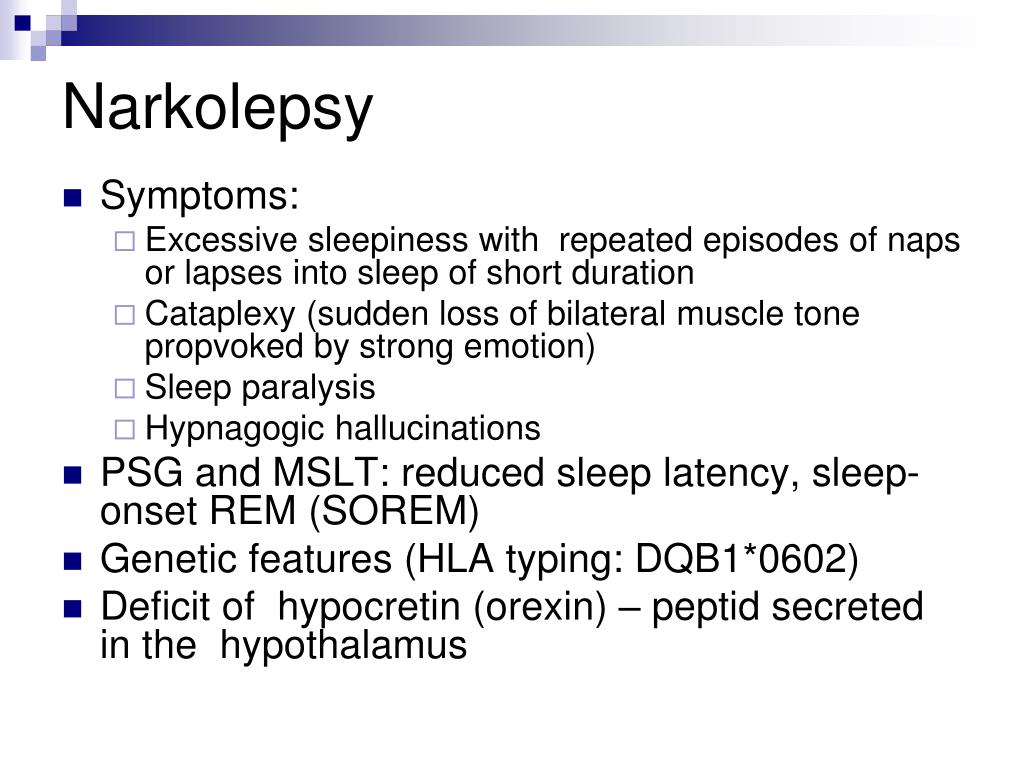

The person remains conscious throughout the episode. Episodes may be triggered by sudden emotional reactions such as laughter, anger, surprise, or fear, and may last from a few seconds to several minutes. Cataplexy is an episodic loss of muscle function, ranging from slight weakness such as limpness at the neck or knees, sagging facial muscles, weakness at the knees often referred to as “knee buckling”, or inability to speak clearly, to a complete body collapse.These symptoms may not occur in all patients. Other symptoms may include automatic behaviors and night-time wakefulness. The classic symptoms of the disorder, often referred to as the “tetrad of narcolepsy,” are cataplexy, sleep paralysis, hypnagogic hallucinations, and excessive daytime sleepiness. Narcoleptics are unique in that they enter into the REM phase of sleep in the beginnings of sleep, even when sleeping during the day. A second prominent symptom of narcolepsy is abnormal REM sleep. In addition, night-time sleep may be fragmented, with frequent awakenings. Drowsiness may persist for prolonged periods or remain constant. Vivid dreams may be experienced on a regular basis, even during very brief naps. They are typically refreshing, but only for a few hours or less. These naps can occur several times a day. In fact, narcoleptics live their entire lives in a constant state of extreme sleep deprivation.ĭaytime naps may occur with little warning and may be physically irresistible. Narcoleptics are not able to experience the amount of restorative deep sleep that healthy people experience – they are not “over-sleeping”. A person with narcolepsy is likely to become drowsy or fall asleep, often at inappropriate times and places, or just be very tired throughout the day. The first, excessive daytime sleepiness (EDS), occurs even after adequate night time sleep. There are two main characteristics of narcolepsy: excessive daytime sleepiness and abnormal REM sleep. The French term was first used in 1880 by Jean-Baptiste-Édouard Gélineau who used the Greek νάρκη ( narkē) meaning “numbness” and λῆψις ( lepsis) meaning “attack”. The term narcolepsy is from the French narcolepsie. Untreated narcolepsy increases the risk of motor vehicle collisions and falls. Ībout 0.2 to 600 per 100,000 people are affected. Tricyclic antidepressants and selective serotonin reuptake inhibitors (SSRIs) may improve cataplexy. While initially effective, tolerance to the benefits may develop over time. Medications used include modafinil, sodium oxybate, and methylphenidate. Lifestyle changes include taking regular short naps and sleep hygiene.

While there is no cure, a number of lifestyle changes and medications may help. Excessive daytime sleepiness can also be caused by other sleep disorders such as sleep apnea, major depressive disorder, anemia, heart failure, drinking alcohol, and not getting enough sleep.

Diagnosis is typically based on the symptoms and sleep studies, after ruling out other potential causes. Trauma, infections, toxins, or psychological stress may also play a role. Often those affected have low levels of the neuropeptide orexin which may be due to an autoimmune disorder. In up to 10% of cases there is a family history of the disorder. The exact cause of narcolepsy is unknown with potentially several causes. People with narcolepsy tend to sleep about the same number of hours per day as people without, but the quality of sleep tends to be worse. Less commonly there may be inability to move or vivid hallucinations while falling asleep or waking up.

These experiences can be brought on by strong emotions. About 70% of those affected also experience episodes of sudden loss of muscle strength, known as cataplexy. Symptoms include periods of excessive daytime sleepiness that usually last from seconds to minutes and may occur at any time. Narcolepsy is a long-term neurological disorder that involves a decreased ability to regulate sleep-wake cycles.


 0 kommentar(er)
0 kommentar(er)
